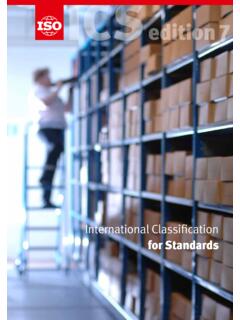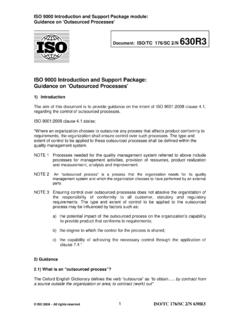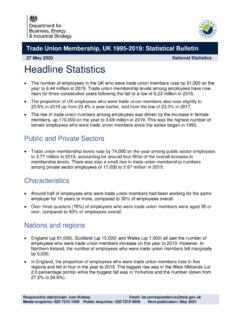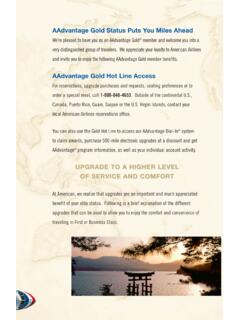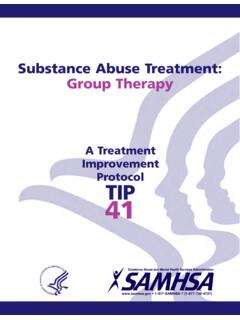Transcription of members - International Organization for Standardization
1 MembersISO membership manualContentsISO : The International Organization for StandardizationISO membership .. 5 ISO membership fees .. 8 ISO member rights, good practice and obligationsMember right 1 Developing ISO standards .. 13 Member right 2 Selling ISO standards and publications, using copyright and the ISO name and logo .. 41 Member right 3 Developing ISO policy .. 45 Member right 4 Governing ISO .. 49 ISO member benefitsIT tools and services .. 57 ISO Academy .. 62 Support for communication and promotion of standards .. 65 ISO : The Inter national Organization for Standardi zation ISO membershipStandards impact an estimated 80 % of world commodity trade. If you are not a full and active member of ISO, you are letting others decide how standards are set and under what conditions your country participates in International trade. ISO membership comes with rights, benefits, good practice and obligations : you need to actively take up your rights and benefits, follow good practice and adhere to your obligations, to deliver excellence in the ISO system and to ISO customers globally.
2 Depending on your member category, you have up to four statutory member rights. These are rights to : 1. Participate in developing ISO standards2. Sell ISO standards and publications, and use copyright and the ISO name and logo3. Participate in developing ISO policy 4. Participate in governing ISOT hese member rights come with statutory obligations and are implemented according to good practice. ISO and its members are also bound by legal obligations, for example on competition or anti-trust, protection of personal data and copyright. As an ISO member, you have access to the largest, global, multi-stakeholder standards community. Our member countries generate some 98 % of world gross national income (GNI) and represent around 97 % of the world s population. ISO membership manual | 5 ISO standards are developed in over 3 000 technical bodies by around 100 000 experts from industry and commerce, government, consumers, labour organizations, academic and research bodies, standards bodies and non-governmental organizations in over 160 countries.
3 Through ISO meetings and events, you share ideas and interact with people who work on standards, drawing on their insight, knowledge and expertise to tackle national, regional and global economic, social and environmental issues. ISO has one member per country. As the national representative of ISO, you are the Organization most representative of Standardization in your country. You can delegate membership rights and obligations to other organizations but you remain responsible to the other ISO members . Many ISO members are part of the government structure in their country or mandated by government. Others are private-sector organizations. ISO is an inclusive Organization with three member categories : subscriber, correspondent and full member (or member body). As the table below shows, the categories give increasing access to, and influence in, the ISO system : Subscriber membersCorrespondent members Full membersParticipating in developing International Standards YesYesYesParticipating in developing policy NoYesYesSelling ISO standards and publications, using copyright and the ISO name and logoNoYesYesParticipating in governing ISONoNoYesTo join ISO or to upgrade your mem-bership, contact the ISO membership team at You need to decide when the membership or upgrade should begin and confirm that you will : Meet all of your obligations as an ISO member Follow ISO rules and decisions Pay your annual membership fees on time When joining ISO, you also need to present documents confirming your status as the Organization most representative of Standardization in your country, and be in a country recognized by the United Nations.
4 The Secretary-General decides on new subscriber and correspondent memberships, and upgrades to correspondent member. ISO Council decides on admissions of, and upgrades to, full also need to let the ISO member-ship team know if your national standards body changes its name or its responsibilities. This ensures that your Organization is properly registered as the ISO member in your country. For information on any aspect of being an ISO member, contact Pamela Tarif, Head of membership at or | ISO membership manual7 ISO membership fees One of your member obligations is to pay your fair share of the costs to maintain the ISO system and Central Secretariat. This is done through membership fees decided by the ISO General Assembly. Paying your fees gives you access to your member rights and are calculated using a unit value and by allocating a number of units to each member.
5 Full member units vary according to economic importance (gross national income, exports and imports) ; correspondent and subscriber members pay a fixed number of units : Full members Unit value x n (n = number of units allocated) Correspondent members Unit value x 2 Subscriber members Unit value x can pay your fees into either ISO bank account :UBS SA Gen ve Swift : UBSWCHZH80 ACr dit Suisse Gen ve Swift : CRESCHZZ12Ac/c N 240 C or c/c N 4835 904847 21 IBAN : CH09 0024 0240 3351 2030 CIBAN : CH17 0483 5090 4847 2100 0 Each September, you receive your member-ship fee invoice for the following year. Full members and correspondent members pay at least 50 % by end March and any balance by end September. Subscriber members pay in full by end September. If you do not pay on time, your membership will be suspended or membersCorrespondent membersSubscriber membersAt least 50 % by end MarchYesYesNoBalance by end SeptemberYesYesNoSingle 100 % payment by end SeptemberNoNoYesFor more information, contact V ronique Hauguel, Head of Finance ,at membership manual | 98 ISO member rights, good practice and obligations MEMBER RIGHT 1 Developing ISO standardsMembers participate in ISO technical committees accord-ing to their national economic, social and environmental priorities.
6 You can see the areas covered by ISO standards on our Website. There are over 220 technical committees plus subcommittees, working groups and study groups. You can send delegates to participate in ISO technical committee work according to your membership category. During 2014 and 2015, correspondent and subscriber members benefit from new member rights that offer increased participation in ISO standards development work. The new rights are for those members whose national standards body wants to participate and gain experience in ISO standards development work but is unable to get support and funding to upgrade immediately to full membership . The new rights mean you can participate in up to five (5) standards development committees ; comment and vote on draft and final draft ISO International Standards ; and build your capacity and develop strategic partnerships through P-member twinnings.
7 More details about these new rights are in this chapter. Or contact the ISO membership team to find out how to get involved. For background on twinning, see our brochure : Guidance on twinning in ISO standards development out more about working in ISO technical committees in My ISO jobISO membership manual | 1312 | ISO membership manualAs the ISO member, you organize consultations among stakeholders in your country to develop a national position on ISO standards. There are many stakeholders who can play a role : industry and commerce, government, consumers, labour organizations, academic and research bodies, standards bodies and non-governmental organizations. For more information, see our brochures Guidance for national standards bodies Engaging stakeholders and building consensus and Guidance for ISO liaison organizations Engaging stakeholders and building committees meet in different locations around the world, in a range of ISO member countries, including developing countries.
8 Physical meetings raise awareness locally about the benefits of International Standardization and virtual meetings reduce the cost of participation. You can offer to host a meeting by contacting the technical committee or subcommittee secretariat concerned, making sure there are no restrictions by your country on the members who would attend. The ISO technical policy (TECH/POL) team helps you by : Resolving problems within or between committees and promot-ing coherence in the technical community Working with the International Electrotechnical Commission (IEC) and Technical Management Board (TMB) to publish the ISO/IEC Directives and Consolidated ISO Sup-plement. These set out the rules for developing International Standards and other publications and are on the ISO Website : policies and directives Being secretariat to the Technical Management Board and informing ISO members about TMB decisions Supporting members in developing new areas for Standardization Promoting the ISO Code of Ethics on how members operate in the ISO System.
9 And the ISO Code of Conduct for those participating in standards development Giving advice on setting up twinning arrangements between developed and developing country members to participate as a P-member, running a secretariat or acting as Commit-tee ChairISO membership manual | 1514 | ISO membership manualThe ISO standards development team : Provides professional advice and guidance to ISO technical committees Coordinates ISO s decentralized standards development process, and Edits and publishes ISO standards Full membersCorrespondent membersSubscriber membersNominate delegates to a technical committee or subcommitteeYes, if you are a member of the committeeYes, in the committees where you are an observer ; and during the new rights pilot, those where you are a P-memberYes, during the new rights pilot, in the committees where you are a P-memberNominate experts to working groupsYes, if you are a P-member of the parent committeeYes, during the new rights pilot, in the committees where you are a P-memberYes, during the new rights pilot, in the committees where you are a P-memberParticipate as an O-member in an ISO technical committee or subcommittee Yes, with rights to comment and voteAs an Observer but no rights to comment or voteNoHold a secretariat, chair or convenorship of an ISO technical committee or subcommittee YesNoTwin as a TC secretaryYesNoNoTwin as a TC ChairYes NoNo Propose a new work item for standards developmentYesNo No Full membersCorrespondent membersSubscriber membersParticipate as a P-member in an ISO technical committee or subcommitteeYesYes, during the new rights pilot.
10 In up to 5 committeesYes, during the new rights pilot, in up to 5 committeesParticipate as a P-member in an ISO working groupYes, if you are a P-member of the parent committeeYes, if you are a P-member of the parent committeeYes, if you are a P-member of the parent committeeTwin as a TC P-memberYes Yes, during the new rights pilot, in the committees where you are a P-memberYes, during the new rights pilot, in the committees where you are a P-memberSubmit comments on draft ISO standardsYes, in the committees where you are a P- or O-member Yes, during the new rights pilot, in the committees where you are a P-memberYes, during the new rights pilot, in the committees where you are a P-memberVote on draft standardsYes, all draft standardsYes, during the new rights pilot, in the committees where you are a P-member Yes, during the new rights pilot, in the committees where you are a P-memberYou have rights to participate in developing ISO standards according to your member category :For more information, contact Sophie Clivio, Director STP, at ISO membership manual | 1716 | ISO membership manualWhen developing ISO standards, you must : Vote on all draft standards in the committees you participate in as a P-member Organize consultations among your stakeholders to develop national positions on draft ISO standards and present them to the relevant ISO technical committees Respect the results of ISO consensus building Follow the ISO Code of Ethics and the ISO Code of Conduct Follow TMB rules and respect TMB decisions When holding secretariats, act without bias and ensure you have the resources to perform your duties18 19 Key questionsTypical evidenceHow is the contribution by all stakeholders assessed when voting ?
